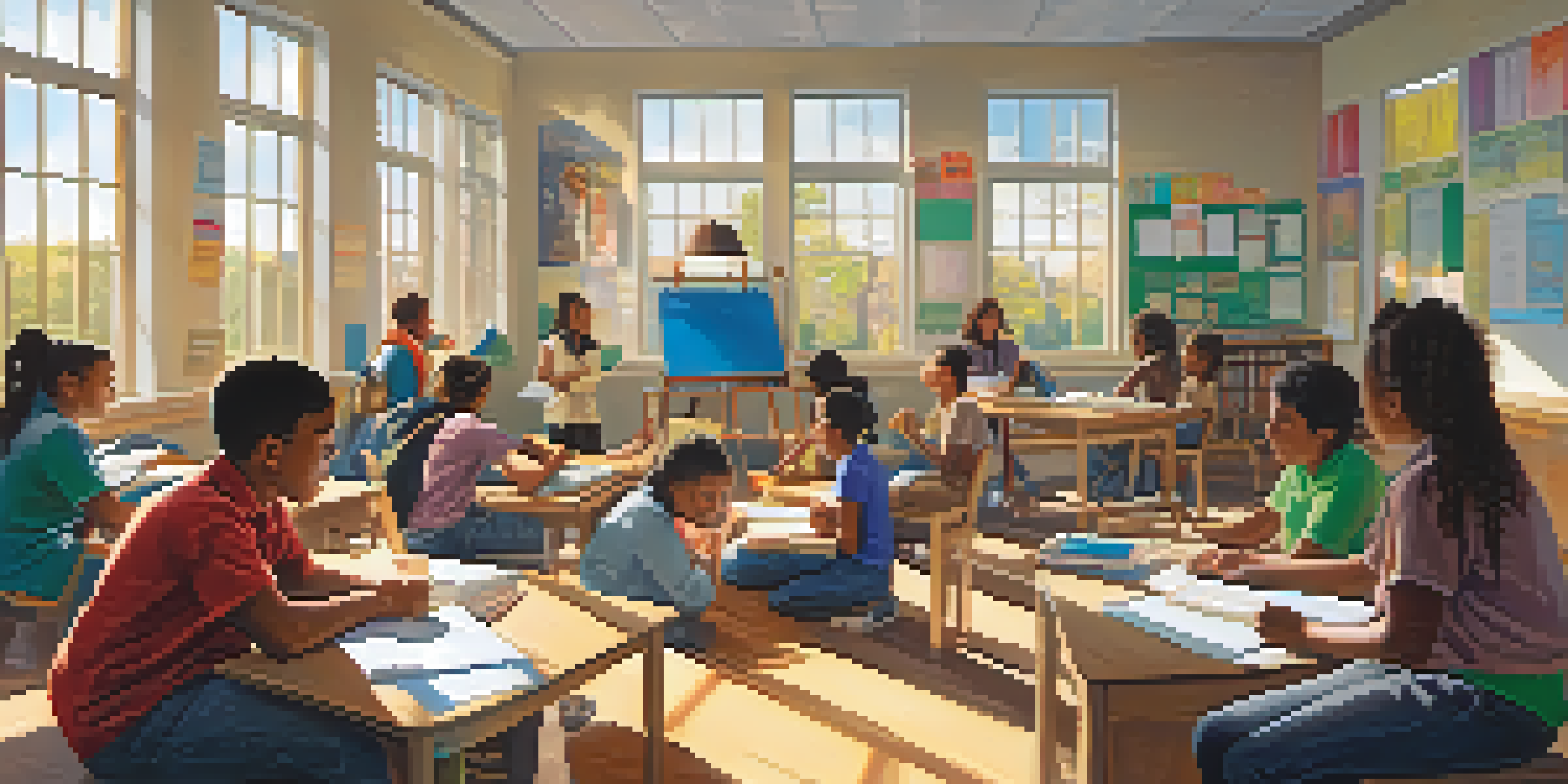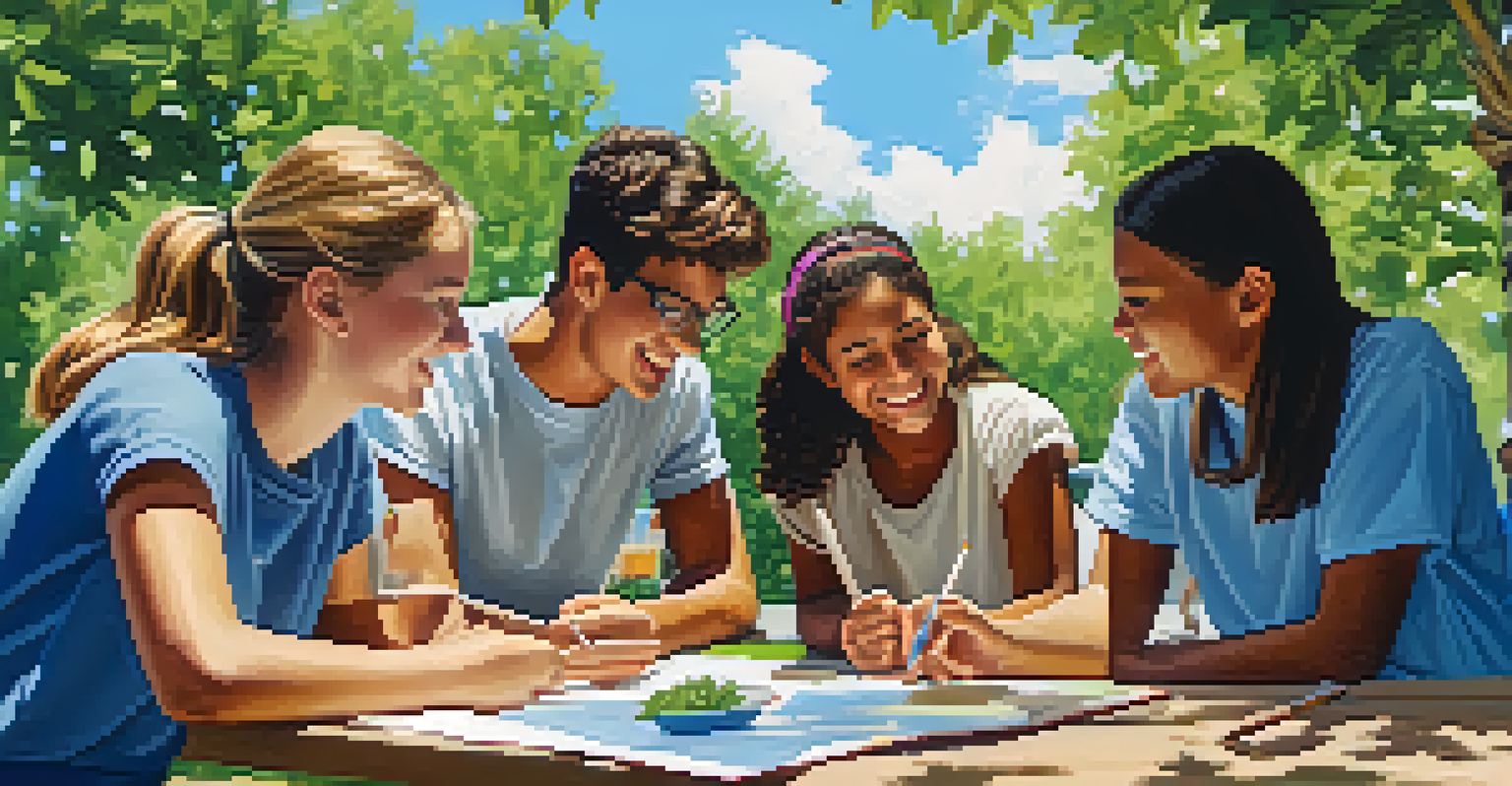Collaborative Learning and Cognitive Development in Students

Understanding Collaborative Learning: A Brief Overview
Collaborative learning is an educational approach that enables students to work together in small groups to solve problems, complete tasks, or create projects. This method fosters an environment where individuals can share diverse perspectives, enhancing the overall learning experience. Think of it like a potluck dinner, where everyone brings a unique dish to share, creating a richer meal than any single person could provide alone.
Alone we can do so little; together we can do so much.
Research has shown that collaborative learning can lead to higher academic achievement and improved critical thinking skills. When students engage with one another, they are not just passively receiving information; they are actively participating in discussions, asking questions, and clarifying concepts. This dynamic exchange helps deepen their understanding and retention of the material.
Moreover, collaborative learning encourages social skills development, such as communication and teamwork. Students learn to navigate different viewpoints, negotiate solutions, and build consensus, skills that are invaluable in both academic and real-world contexts. In essence, collaborative learning equips students with not just knowledge, but the interpersonal skills they need for future success.
The Role of Cognitive Development in Learning
Cognitive development refers to the progression of thinking, problem-solving, and decision-making abilities in students as they grow. This process is crucial to how effectively students can absorb and apply new information. Imagine cognitive development as a garden; the more you nurture it with diverse activities, the more it flourishes.

As students engage in collaborative learning, they stimulate their cognitive development by challenging each other’s ideas and assumptions. This interaction pushes them to think critically and creatively, leading to a deeper comprehension of concepts. Studies have shown that this type of engagement can significantly enhance memory and information retention.
Collaborative Learning Boosts Skills
Working together in groups enhances critical thinking, communication, and social skills among students.
Additionally, collaborative learning helps to build metacognitive skills, which allow students to reflect on their own thought processes. By discussing their reasoning and strategies with peers, students gain insights into how they learn best, paving the way for more effective study habits and problem-solving techniques in the future.
How Collaboration Enhances Critical Thinking Skills
Critical thinking is the ability to analyze facts, evaluate arguments, and make informed decisions. Collaborative learning environments provide students with the perfect platform to practice these skills. When students work together, they are often faced with differing opinions and must weigh the validity of each perspective, much like a jury deliberating over a case.
Collaboration allows us to know more than we are capable of knowing by ourselves.
Through discussions and debates, students learn to articulate their thoughts clearly and support their arguments with evidence. They also develop the ability to listen actively and consider alternative viewpoints, which are essential components of critical thinking. This process not only strengthens their reasoning skills but also prepares them for real-world problem-solving scenarios.
Furthermore, collaboration encourages a culture of inquiry. Students feel more comfortable asking questions and seeking clarification from their peers, leading to a deeper exploration of topics. This environment cultivates a mindset where questioning is valued, ultimately driving intellectual curiosity and a life-long love of learning.
The Benefits of Social Interaction in Learning
Social interaction is a fundamental aspect of collaborative learning, as it fosters connections among students. These relationships can enhance motivation and engagement, creating a sense of belonging in the classroom. Think of it as being part of a sports team; when students feel like they are part of a community, they are more likely to participate actively and take risks in their learning.
Moreover, social interaction helps students develop empathy and emotional intelligence. By working closely with their peers, students learn to appreciate different perspectives and backgrounds, which is essential in today's diverse world. This exposure can lead to more inclusive attitudes and greater respect for others.
Cognitive Development Thrives in Groups
Engaging with peers challenges students' thinking and promotes deeper understanding and retention of concepts.
Additionally, the support gained from collaborative efforts can reduce anxiety and stress associated with academic challenges. Students can share their struggles and celebrate their victories together, creating a supportive atmosphere that encourages resilience. This communal approach to learning can make even the toughest subjects feel more manageable.
Strategies for Effective Collaborative Learning
To maximize the benefits of collaborative learning, educators can implement specific strategies that promote effective group dynamics. One key approach is to establish clear roles within groups, ensuring that each student has a defined responsibility. This structure can help prevent confusion and ensure that every voice is heard, much like a well-conducted orchestra.
Another effective strategy is to provide structured tasks that require collaboration to complete. Assignments that cannot be solved individually encourage students to work together, fostering a sense of interdependence. Think of it as a puzzle; each student holds a piece that contributes to the overall picture.
Finally, regular reflection sessions can enhance the collaborative experience. Allowing students to discuss what worked, what didn’t, and how they can improve their teamwork fosters a growth mindset. This practice not only reinforces learning but also equips students with the skills to collaborate effectively in future endeavors.
Challenges of Collaborative Learning and How to Overcome Them
While collaborative learning offers numerous benefits, it’s not without its challenges. One common issue is unequal participation, where some students take on more work than others. This can lead to frustration and resentment within the group, much like when one person does all the cooking for a potluck.
To combat this, educators can encourage accountability by assigning roles and rotating them regularly. This ensures that all students contribute to the group’s success and learn to value each other’s strengths. Additionally, setting clear expectations and monitoring group dynamics can help maintain balance and fairness.
Social Interaction Enhances Engagement
Building connections through collaboration fosters motivation, empathy, and a sense of belonging in the learning environment.
Another challenge is the potential for conflict among group members. Disagreements can arise, but when managed effectively, they can be an opportunity for growth. Teaching conflict resolution skills and encouraging open communication can help students navigate these situations, ultimately strengthening their collaborative abilities.
Future Implications of Collaborative Learning in Education
As education continues to evolve, the importance of collaborative learning is becoming increasingly recognized. With the rise of technology, online collaborative tools are transforming how students interact and learn together, breaking down geographical barriers. Imagine a virtual classroom where students from different continents can collaborate on a project, enriching their learning experience through diverse perspectives.
Furthermore, the skills developed through collaborative learning—such as critical thinking, communication, and teamwork—are essential for success in the modern workforce. Employers increasingly seek individuals who can collaborate effectively in diverse teams, making these skills a vital component of a well-rounded education.

In conclusion, the future of education lies in embracing collaborative learning as a key strategy for fostering cognitive development. By prioritizing group work and social interaction, educators can equip students with the skills they need to thrive academically and professionally in an ever-changing world.